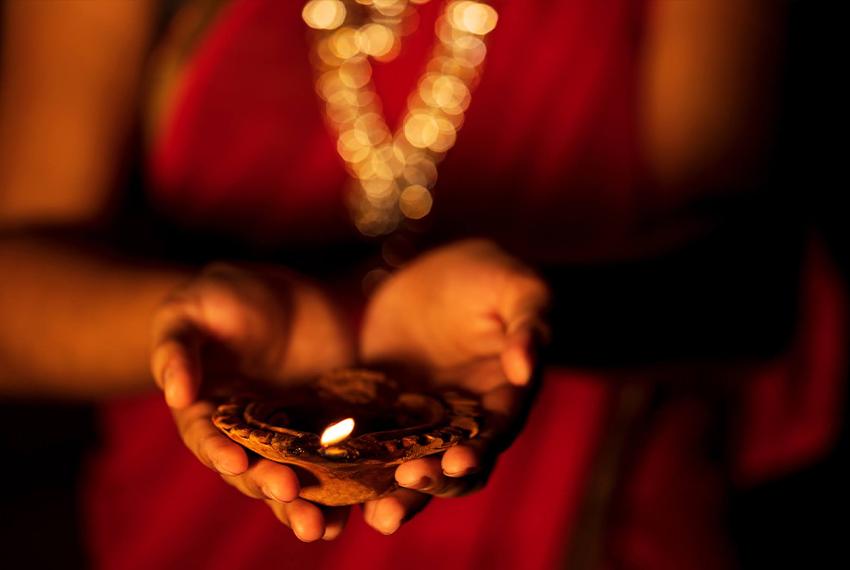Derived from the Sanskrit word, Dhanteras literally means the 13th day that corresponds to wealth. It falls on the lunar day of Krishna Paksha in the month of Kartik. The auspicious day marks the beginning of festivities of Diwali, which includes Laxmi Poojan and Bhaidooj. The day is known to translate to wealth and prosperity, along with the sense of abundance, and a firm belief that whatever is needed, shall come. It is commemorated by the fact that when you put your earnings in front of you and feel the abundance, gratitude is bound to attract more abundance. It is a reiteration of what Chanakya said “ DharmasyaMoolamArthah”, which means that prosperity is the root of righteousness.
The day marks the birth anniversary of Lord Dhanvantri, the teacher and father of Ayurveda. The ancient physician is traditionally associated with Ayurveda knowledge. No wonder so many temples in South India are corroborated with the idols of Lord Dhanvantri, prophesizing the geographical advantage, legacy in ancient medicine diversity, and ayurvedic practices. Emblematically, it is a resonation to pursue the kindness of nature, which is a treasure trove of health and wealth.
Ancient sages have brought sacredness to every ritual; and thus, brought depth in the celebration, as is the nature of the spirit. An episode narrated in the Samudra Manthan is suggestive of a mystical tale about how Lord Dhanvantri emerged from the ocean during the cosmic battle between gods and demons in the search for immortal water, Amrit. In the quest to search for the immortal elixir, the sea was churned, Mandara Mountain became the churning rod, Vasuki, the king of serpents, became the rope and Vishnu took the avatar of the tortoise and lifted the mountain on the back, The physician of gods is renowned and revered for having imparted the wisdom of Ayurveda, for the betterment of mankind and helped get rid of ailment and sufferings. As the sages started to praise the lord’s glory, the showered the holy water, the lord went in and brought the jar of elixir. Lord Vishnu defeated the demons and gave the jar to Gods.
Another famous mythological legend is dedicated to the 16-year-old son of the king, Hima, whose horoscope foretold that his end was certain on the fourth day of the marriage. His wife did not let him sleep all night, keeping him preoccupied with the narratives and songs, to keep him from sleeping. At the threshold of his chamber, she laid the ornaments and lighted diyas to keep away the ill spirits. When the Yam arrived in the form of a serpent, it was blinded by the sheer illuminance and dazzle of the mounted ornaments and was engrossed listening to the melodious narratives from the wife to the husband, In the morning, it quietly departed without fulfilling the very purpose of taking Hima’s life. Thus, the princess managed to save her husband from the clutches of death. To keep family members safe, wear jewellery, and put diyas Aimed at praying for the prosperity of the household and health and long life of the husband.
Dhanteras sets the auspicious mood for Diwali. It encompasses themes of cleaning, renewal, and securing of auspiciousness in the form of Laxmi. Houses are cleaned to make space for new purchases, just like it is the time to discard old, redundant thoughts and embark on new ventures.

People worship goddess Laxmi and Lord Kuber, the god of wealth, on the eve of Dhanteras and eulogize them with fruits and flowers. Laxmi pooja is done during pradosh kaal, which starts after sunset and lasts for 2 hours 24 minutes. The swastika is marked on the plate with sindoor, earthen diya is lighted, tilak is put on the lamp, and offered sugar, flowers, and rice. New clothes, spectacular firecrackers, succulent sweets, and melodious hymns become a spectacle of rituals and customary sacred endeavors.
Premises and streets are streets are illuminated with rows of clay lamps and homes are decorated with colors and candles. It is believed that goddess Laxmi visits the homes of devotees and fulfills their wishes. Traditional and colourful motifs of rangoli welcome goddess Laxmi, and to indicate the long-awaited arrival of the goddess, small footprints are marked with rice, flower, and sindoor all over the place in the house and workplace, and the ladies of the house light diyas throughout the night as an offering to Yam, the god of death and avert untimely death in the household.
Since time immemorable, it has been believed that purchasing metals act as protection against ill will. The ritual of buying utensils, silver, and gold ornaments is said to be the harbinger of prosperity, and known to protect one against ill-luck and is Gold and metals are known to have higher resale value than the buying value, and hence promoted and popularized. They are not just a precious metal, but also have sentimental value for the people of India.
It embraces a unique worth for business communities as they purchase valuables and luxurious products on this day. It is ritualistic to buy metals, as metals are known to please the goddess and thus attract more wealth and prosperity.
This Dhanteras, let us reminisce and celebrate the abundance of life, and let the festival of lights encourage us to the profound truth of life, to awaken the latent values and respect the good qualities of humans as forbearance, generosity, love, kindness, and strength. The row of light also reminds us that every aspect of life needs attention and the light of knowledge.

